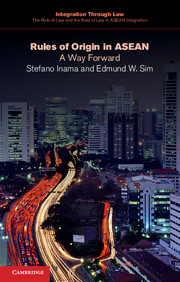Book contents
- Frontmatter
- Contents
- List of Tables
- General Editors’ preface
- Preface
- List of Abbreviations
- Chapter 1 Introduction
- Chapter 2 The initial set of ASEAN rules of origin: the lack of clarity and transparency masquerading as simplicity 1992–1995
- Chapter 3 Externalizing the confusion: the proliferation of rules in the ASEAN FTAs with dialogue partners
- Chapter 4 The silent cost: the cumbersome administration of ASEAN rules of origin
- Chapter 5 The possible way forward: self-certification
- Chapter 6 Conclusion and recommendations
- Executive Summary
- Appendices
- Bibliography
- Index
Preface
Published online by Cambridge University Press: 05 March 2015
- Frontmatter
- Contents
- List of Tables
- General Editors’ preface
- Preface
- List of Abbreviations
- Chapter 1 Introduction
- Chapter 2 The initial set of ASEAN rules of origin: the lack of clarity and transparency masquerading as simplicity 1992–1995
- Chapter 3 Externalizing the confusion: the proliferation of rules in the ASEAN FTAs with dialogue partners
- Chapter 4 The silent cost: the cumbersome administration of ASEAN rules of origin
- Chapter 5 The possible way forward: self-certification
- Chapter 6 Conclusion and recommendations
- Executive Summary
- Appendices
- Bibliography
- Index
Summary
The rules of origin (RoOs) constitute a fundamental foundation for any preferential trade agreement (PTA) involving trade in goods. RoOs are similar to nationality and citizenship rules for natural persons in a nation-state, in that both sets of rules establish the rights and privileges applicable to qualifying persons or goods. Nationality and citizenship rules determine who may enjoy the benefits of citizenship, such as freedom of movement, permanent residency and the like. Similarly, RoOs determine the applicable duty rate and other treatment for goods in the PTA.
RoOs generally fall into three types:
RoOs based on the “wholly originating” principle apply to goods which are naturally occurring (such as minerals) or grown/harvested (such as agricultural products). Human involvement in the production of such goods is limited to extracting, cultivating and/or harvesting the goods. In such circumstances, the country of origin is where the extraction, cultivation or harvest has taken place, i.e., the product “wholly originates” in that country.
RoOs based on qualitative analysis examine the extent to which a good has been further processed into another good, with an emphasis on the processing that has taken place in that country. In the “substantial transformation” standard, the relevant authorities examine the nature of the processing and whether the product has been fundamentally changed into another product. Another approach is the “change in tariff classification,” which examines whether the initial product and the processed products are classified differently under the Harmonized Tariff Schedule (HTS); sufficient deviation in HTS classification confers origin under this type of RoO. Finally, there are special product-specific RoOs that provide for specific processes as conferring origin on the product; these product-specific rules are commonly used for textiles.
RoOs based on quantitative analysis examine the value added by the processing in the country. This approach is known as “regional value content,” under which the relevant authorities examine the value of the goods input into the production process, labor, overheads, and other costs. If after processing the resulting product meets a specified criterion, that product will satisfy the RoO.
- Type
- Chapter
- Information
- Rules of Origin in ASEANA Way Forward, pp. xvi - xxPublisher: Cambridge University PressPrint publication year: 2015

